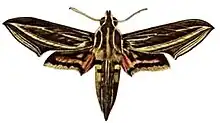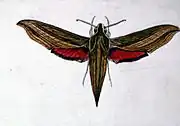| Cyrtorchis | |
|---|---|
 | |
| Cyrtorchis arcuata cultivated in a botanical garden | |
| Scientific classification | |
| Kingdom: | Plantae |
| Clade: | Tracheophytes |
| Clade: | Angiosperms |
| Clade: | Monocots |
| Order: | Asparagales |
| Family: | Orchidaceae |
| Subfamily: | Epidendroideae |
| Tribe: | Vandeae |
| Subtribe: | Angraecinae |
| Genus: | Cyrtorchis Schltr. |
| Type species | |
| Cyrtorchis arcuata (Lindl.) Schltr. | |
| Synonyms[1] | |
|
Homocolleticon (Summerh.) Szlach. & Olszewski | |


Cyrtorchis is a genus of flowering plants from the orchid family Orchidaceae native to Africa.[1]
Description
The species of the genus Cyrtorchis are epiphytic or lithophytic herbs,[3] which do not have pseudobulbs.[4] The white, fragrant, star-shaped flowers are distinctly spurred.[2]
Cytology
The diploid chromosome count of Cyrtorchis arcuata is 2n = 46.[5]
Physiology
Cyrtorchis is known to utilize the crassulacean acid metabolism,[5] which entails photosynthesis during the daytime, and gaseous exchange through open stomata during the night. This enables the plant to save water.[6]
Etymology
The generic name Cyrtorchis is composed of the Greek words "kirtos" meaning curved and "orchis" meaning testicles, which refers to orchids.[7]
Taxonomy
The genus has been proven to be monophyletic.[8]
Sections
The genus has been divided into the sections Cyrtorchis section Homocolleticon Summerh. and Cyrtorchis section Cyrtorchis based on differences in the shape of the viscidium.[2] Originally the section Cyrtorchis was published as section Heterocolleticon Summerh., but it is now known as Cyrtorchis section Cyrtorchis.[9][10] The section Homocolleticon is characterized by an uniformly textured viscidium,[11] in contrast to the viscidium of section Cyrtorchis, which consists of two distinct zones.[12]
The section Homocolleticon Summerh. was elevated to a genus by Szlach. & Olszewski in 2001, but Homocolleticon (Summerh.) Szlach. & Olszewski is now a synonym of Cyrtorchis Schltr.[1][9]
Species
As of December 2022, there are 19 currently accepted species:[1]
- Cyrtorchis arcuata (Lindl.) Schltr.
- Cyrtorchis aschersonii (Kraenzl.) Schltr.
- Cyrtorchis brownii (Rolfe) Schltr.
- Cyrtorchis chailluana (Hook.f.) Schltr.
- Cyrtorchis crassifolia Schltr. in R.E.Fries
- Cyrtorchis erythraeae (Rolfe) Schltr.
- Cyrtorchis glaucifolia Summerh.
- Cyrtorchis guillaumetii (Pérez-Vera) R.Rice
- Cyrtorchis hamata (Rolfe) Schltr.
- Cyrtorchis henriquesiana (Ridl.) Schltr.
- Cyrtorchis injoloensis (De Wild.) Schltr.
- Cyrtorchis letouzeyi Szlach. & Olszewski
- Cyrtorchis monteiroae (Rchb.f.) Schltr.
- Cyrtorchis neglecta Summerh.
- Cyrtorchis okuensis Droissart, Azandi & M.Simo
- Cyrtorchis praetermissa Summerh.
- Cyrtorchis ringens (Rchb.f.) Summerh
- Cyrtorchis seretii (De Wild.) Schltr.
- Cyrtorchis submontana Stévart, Droissart & Azandi
Species formerly placed in Cyrtorchis
Ecology
Habitat
It grows in dense forests and rainforests, as well as in plantations. It is found growing on tree trunks and branches, which receive high levels of sunlight.[15] In addition to epiphytic growth, it can also grow as a lithophyte attached to rocks.[3]
Pollination
Several hawk moth species of the genus Hippotion have been identified as likely pollinators of Cyrtorchis okuensis.[16] The white flowers shift to an orange pollination[2][3] after pollination or senescence. Such post-pollination behaviour is not uncommon, and it may be explained by a reduced attractivity of flowers to pollinators,[7][17][18][19] if the flowers are no longer viable.
 Young, viable Cyrtorchis arcuata inflorescence without discolouration
Young, viable Cyrtorchis arcuata inflorescence without discolouration Older Cyrtorchis arcuata inflorescence exhibiting senescence and discolouration of older, non-viable flowers
Older Cyrtorchis arcuata inflorescence exhibiting senescence and discolouration of older, non-viable flowers Hippotion celerio, a likely pollinator of Cyrtorchis okuensis[16]
Hippotion celerio, a likely pollinator of Cyrtorchis okuensis[16] Hippotion osiris, a likely pollinator of Cyrtorchis okuensis[16]
Hippotion osiris, a likely pollinator of Cyrtorchis okuensis[16] Hippotion eson, a likely pollinator of Cyrtorchis okuensis[16]
Hippotion eson, a likely pollinator of Cyrtorchis okuensis[16]
Conservation
Two species, namely Cyrtorchis letouzeyi Szlach. & Olszewski and Cyrtorchis henriquesiana (Ridl.) Schltr., have been categorized as species of least concern (LC) under the IUCN Red List criteria.[20][21] Cyrtorchis arcuata subsp. arcuata has been categorized as a Least Concern species by the Red List of South African Plants.[22] Another species, Cyrtorchis glaucifolia Summerh., has been categorized as an endangered (EN) species under the IUCN Red List criteria,[23] and Cyrtorchis okuensis Droissart, Azandi & M.Simo is categorized as Near Threatened (NT).[16]
Horticulture
Cyrtorchis is easy to cultivate in well drained substrate.[2] Cyrtorchis arcuata is most commonly found in private collections.[7]
See also
References
- 1 2 3 4 "Cyrtorchis Schltr". Plants of the World Online. Royal Botanic Gardens, Kew. Retrieved 23 December 2022.
- 1 2 3 4 5 Leth, C. (n.d.). Genus Cyrtorchis. African Orchids. Retrieved December 24, 2022, from http://www.africanorchids.dk/higher-epidendroideae/tribe-vandeae/subtribe-aerangidinae-from-a-m/cyrtorchis
- 1 2 3 4 Hyde, M.A., Wursten, B.T., Ballings, P. & Coates Palgrave, M. (2022). Flora of Mozambique: Genus page: Cyrtorchis. https://www.mozambiqueflora.com/speciesdata/genus.php?genus_id=444, retrieved 25 December 2022
- ↑ Hyde, M.A., Wursten, B.T., Ballings, P. & Coates Palgrave, M. (2022). Flora of Malawi: Genus page: Cyrtorchis. https://www.malawiflora.com/speciesdata/genus.php?genus_id=444, retrieved 25 December 2022
- 1 2 Cyrtorchis arcuata. (n.d.). Hortus Orchis. Retrieved December 26, 2022, from https://www.hortusorchis.org/en/botanical-orchids/107-c/1256-cyrtorchis-arcuata.html
- ↑ Töpfer, N., Braam, T., Shameer, S., Ratcliffe, R. G., & Sweetlove, L. J. (2020). "CAM emerges in a leaf metabolic model under water-saving constraints in different environments." bioRxiv.
- 1 2 3 De Vidi, G. (2010, December 10). Il genere Cyrtorchis. Orchids.it. Retrieved December 26, 2022, from https://www.orchids.it/2010/12/10/il-genere-cyrtorchis/
- ↑ Schuiteman, A. (2018). "Orchid Research Newsletter No. 71."
- 1 2 Azandi, L., Droissart, V., Sonké, B., Simo-Droissart, M., & Stévart, T. (2018). "The genus Cyrtorchis in Central Africa with a focus on its two sections." Orchids, 87(1), 48-55.
- ↑ Cribb, P. (2017). "Flora of Tropical East Africa: Orchidaceae (Part 3)." p. 226. CRC Press.
- ↑ Leth, C. (n.d.). Cyrtorchis section Homocolleticon. African Orchids. Retrieved December 24, 2022, from http://www.africanorchids.dk/higher-epidendroideae/tribe-vandeae/subtribe-aerangidinae-from-a-m/cyrtorchis
- ↑ Leth, C. (n.d.). Cyrtorchis section Cyrtorchis. African Orchids. Retrieved December 24, 2022, from http://www.africanorchids.dk/higher-epidendroideae/tribe-vandeae/subtribe-aerangidinae-from-a-m/cyrtorchis
- ↑ "Ypsilopus amaniensis (Kraenzl.) D'haijère & Stévart". Plants of the World Online. Royal Botanic Gardens, Kew. Retrieved 1 January 2022.
- ↑ "Ancistrorhynchus refractus (Kraenzl.) Summerh". Plants of the World Online. Royal Botanic Gardens, Kew. Retrieved 1 January 2022.
- ↑ Cyrtorchis aschersonii (Kraenzl.) Schltr. (2022, July 5). African Plant Database. Retrieved December 24, 2022, from https://africanplantdatabase.ch/en/nomen/44969
- 1 2 3 4 5 Azandi, L. N., Stévart, T., Sonké, B., Simo-Droissart, M., d'Haijère, T., & Droissart, V. (2021). "Taxonomic description and pollination ecology of Cyrtorchis okuensis (Orchidaceae, Angraecinae), a new species endemic to the Cameroon Volcanic Line." Plant Ecology and Evolution, 154(3), 483-496.
- ↑ Weiss, M. R., & Lamont, B. B. (1997). "Floral color change and insect pollination: a dynamic relationship." Israel Journal of Plant Sciences, 45(2-3), 185-199.
- ↑ Ruxton, G. D., & Schaefer, H. M. (2016). Floral colour change as a potential signal to pollinators. Current opinion in plant biology, 32, 96-100.
- ↑ Dalström, S., Gyeltshen, N., & Höijer, T. (2010). Phalaenopsis taenialis: a case of split personality. Orchids, 79(8), 468-471.
- ↑ Simo-Droissart, M., Stévart, T. & Droissart, V. 2021. Cyrtorchis letouzeyi. The IUCN Red List of Threatened Species 2021: e.T87585357A87740052. https://dx.doi.org/10.2305/IUCN.UK.2021-3.RLTS.T87585357A87740052.en. Accessed on 26 December 2022.
- ↑ Simo-Droissart, M., Stévart, T. & Droissart, V. 2021. Cyrtorchis henriquesiana. The IUCN Red List of Threatened Species 2021: e.T87585350A87740047. https://dx.doi.org/10.2305/IUCN.UK.2021-3.RLTS.T87585350A87740047.en. Accessed on 26 December 2022.
- ↑ Foden, W. & Potter, L. 2005. Cyrtorchis arcuata (Lindl.) Schltr. subsp. arcuata. National Assessment: Red List of South African Plants version 2020.1. Accessed on 2022/12/26
- ↑ Rokni, S., Matimele, H.A., Alves, M.T., Chelene, I., Darbyshire, I., Datizua, C., De Sousa, C., Langa, C., Massingue, A.O., Mucaleque, P.A., Odorico, D., Osborne, J., Rulkens, A.J.H., Timberlake, J. & Viegas, A. 2018. Cyrtorchis glaucifolia. The IUCN Red List of Threatened Species 2018: e.T120961124A120980358. https://dx.doi.org/10.2305/IUCN.UK.2018-2.RLTS.T120961124A120980358.en. Accessed on 26 December 2022.
External links
 Media related to Cyrtorchis at Wikimedia Commons
Media related to Cyrtorchis at Wikimedia Commons Data related to Cyrtorchis at Wikispecies
Data related to Cyrtorchis at Wikispecies
